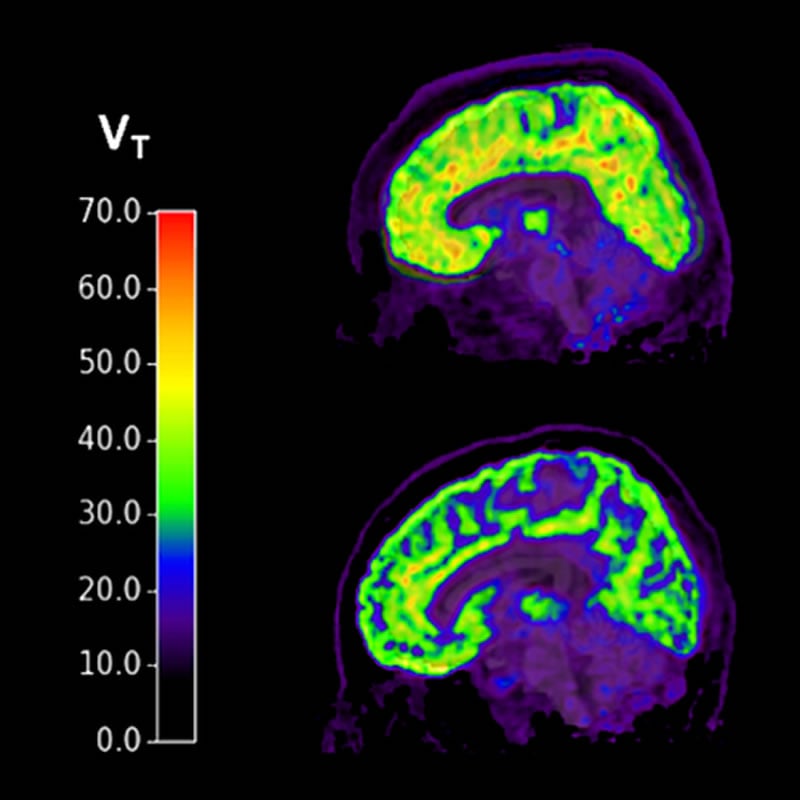Summary: PET imaging study reveals higher levels of mGluR5 in those with PTSD who had suicidal thoughts. The findings could serve as a biomarker to assess suicide risk in people with PTSD.
Source: Yale
The risk of suicide among individuals with post-traumatic stress disorder (PTSD) is much higher than the general population, but identifying those individuals at greatest risk has been difficult. However, a team at Yale has discovered a biological marker linked to individuals with PTSD who are most likely to think about suicide, the researchers report May 13 in the journal Proceedings of the National Academy of Sciences.
Researchers used PET imaging to measure levels of metabotropic glutamatergic receptor 5 (mGluR5) — which has been implicated in anxiety and mood disorders — in individuals with PTSD and major depressive disorder. They found high levels of mGluR5 in the PTSD group with current suicidal thoughts. They found no such elevated levels in the PTSD group with no suicidal thoughts or in those with depression, with or without current suicidal thoughts.
There are two FDA approved treatments for PTSD, both of which are anti-depressants. It can take weeks or months to determine whether they are effective. That can be too late for those who are suicidal, note the researchers.

“If you have people who suffer from high blood pressure, you want to reduce those levels right away,” said Irina Esterlis, associate professor of psychiatry at Yale and senior author of the study. “We don’t have that option with PTSD.”
Esterlis said testing for levels of mGluR5 in people who have experienced severe trauma might help identify those at greatest risk of harming themselves and prompt psychiatric interventions. Also, researchers might investigate ways to regulate levels mGluR5 with hopes of minimizing suicide risk in PTSD patients, she said.
Yale’s Margaret T. Davis is lead author of the paper.
Funding: Funding support was provided by the Veterans Affairs National Center for PTSD (R.H.P., R.S.D., J.H.K., and I.E.), National Institute of Mental Health (NIMH) Grants K01MH092681 and R01MH104459 (to I.E.) and K08 MH117351-01 (to M.T.D.), National Institute on Drug Abuse Grant T32 DA022975-9 (to M.T.D.), a Dana Foundation Grant (to I.E.), and the YCCI.
Source:
Yale
Media Contacts:
Bill Hathaway – Yale
Image Source:
The image is credited to Davis et al.
Original Research: Open access
“In vivo evidence for dysregulation of mGluR5 as a biomarker of suicidal ideation” Margaret T. Davis, Ansel Hillmer, Sophie E. Holmes, Robert H. Pietrzak, Nicole DellaGioia, Nabeel Nabulsi, David Matuskey, Gustavo Angarita-Africano, Richard E. Carson, John H. Krystal, and Irina Esterlis.
PNAS. doi:10.1073/pnas.1818871116
Abstract
In vivo evidence for dysregulation of mGluR5 as a biomarker of suicidal ideation
Recent evidence implicates dysregulation of metabotropic glutamatergic receptor 5 (mGluR5) in pathophysiology of PTSD and suicidality. Using positron emission tomography and [18F]FPEB, we quantified mGluR5 availability in vivo in individuals with PTSD (n = 29) and MDD (n = 29) as a function of suicidal ideation (SI) to compare with that of healthy comparison controls (HC; n = 29). Volume of distribution was computed using a venous input function in the five key frontal and limbic brain regions. We observed significantly higher mGluR5 availability in PTSD compared with HC individuals in all regions of interest (P’s = 0.001–0.01) and compared with MDD individuals in three regions (P’s = 0.007). mGluR5 availability was not significantly different between MDD and HC individuals (P = 0.17). Importantly, we observed an up-regulation in mGluR5 availability in the PTSD-SI group (P’s = 0.001–0.007) compared with PTSD individuals without SI. Findings point to the potential role for mGluR5 as a target for intervention and, potentially, suicide risk management in PTSD.






